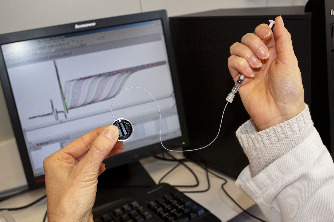View All Molecular Biophysics at Instruct
Instruct Centre-FR1 offers state-of-the-art equipment and expertise to perform biophysical analysis and quality control on protein samples. Techniques include Analytical ultracentrifugation (AUC), Isothermal titration calorimetry (ITC), Microscale Thermophoresis, SEC-MALS, Thermal Shift assay and Mass Photometry (MP).
ITC microcalorimetry is the gold standard for measuring biomolecular interactions, providing simultaneously a precise determination of all binding parameters in one single experiment (stoichiometry or active fraction, dissociation constant, DG, DH, DS). An advantage of ITC over other biophysical approaches is that ITC is a true in-solution technique which does not require sample labeling and that even interactions arising from complex systems can be resolved. In addition, it has virtually no upper or lower limits for the size of binding partners and the sample can be recovered for further biophysical and structural characterization (DLS, X-ray, NMR or cryo-EM), making it possible to use ITC as a quality control checkpoint for complex formation and homogeneity. Finally, the kinITC strategy allows an accurate determination of kinetic parameters (kon, koff) in addition of thermodynamic parameters.
The advanced ITC microcalorimetry facility including kinITC capabilities and the possibility to handle complex interactions is hosted at the IBMC institute. For any question about this service, please contact Eric Ennifar (e.ennifar@unistra.fr).
Device: ITC200 (MicroCal) and PEAQ-ITC (Malvern Panalyticals)
Device: Proteomelab XL-I
Bio-Layer Interferometry (BLI) is a label-free technology for measuring biomolecular interactions. It is a fast and high throughput technique that enables real-time analysis for determination of affinity, kinetics and concentration.
The equipment is an Octet® R8 System from Sartorius.
FIDA combines Taylor dispersion analysis (TDA) and fluorescence detection in straight fused silica capillaries to measure biomolecular size, enabling accurate determination of hydrodynamic radius (Rh) and size-based characterization of biomolecular interactions. Species of Rh between 0.5 and 1000 nm can be analyzed, and different populations resolved. Size changes down to 5% hydrodynamic radius can be detected. For biomolecular complex characterization, measurements at different concentrations of analyte (= non-fluorescent binding partner) and constant concentration of the indicator (= fluorescent biomolecule) result in a binding curve from which the dissociation constant Kd and Rh of indicator and complex are obtained. Measurements using Fida1 can be performed in plasma, serum, cell lysate and fermentation media.
Device: Fida1 (Fidabio) with 480 nm ex LED fluorescence detection
Microcal PEAQ-ITC (Malvern)
Mass photometry (MP) is a label-free technology delivering accurate mass measurements of molecules in solution in their native state. It enables among others the monitoring of macromolecular complex formation and characterization of sample heterogeneity using very little sample (usually 2 µl at 100 nM).
The equipment is a TwoMP instrument from Refeyn
MST can monitor the binding of single ions (40Da) or small molecules (300Da) to a target as well as the binding of ribosomes (2.5MDa).The thermophoresis is detected and quantified using either covalently attached or intrinsic fluorophores. For example, the thermophoresis of a protein typically differs significantly from the thermophoresis of a protein–ligand complex due to binding-induced changes in size, charge and solvation energy. For deriving binding constants, multiple capillaries with constant concentrations of protein and increasing concentration of ligand are scanned consecutively and thermophoresis is detected.
The analysis software is used to calculate the dissociation coefficient.
System components: Multi-angle light scattering detector: miniDAWN TREOS from Wyatt Technology. Equipped with the QELS module which enables measurement of the hydrodynamic radius. Differential Refractive Index (dRI) detector: Optilab T-rEX from Wyatt Technology. Chromatography system: Ettan MicroLC from GE Healthcare.
Device: Thermofluor (use of extrinsic fluorescent dye to label the proteins) and Prometheus (no dye, native intrinsic fluorescence from the proteins).
AUC allows the characterisation of macromolecules and macromolecular self- and hetero-association processes in solution. Two types of complementary experiments, sedimentation velocity and sedimentation equilibrium, can be performed in an analytical ultracentrifuge which is a high-speed centrifuge equipped with an optical detection system. The observation of macromolecules or macromolecular complexes sedimentation gives access to their hydrodynamic and thermodynamic properties, including their size, shape, molar mass, degree of heterogeneity, oligomeric state, stoichiometry, and binding constants.
ITC is used to investigate all types of protein interactions, including protein-protein interactions, protein-DNA/RNA interactions and protein-small molecule interactions.
MST is a powerful new technology to quantify biomolecular interactions in a few microliter solution. MST measures changes of mobility of the molecules in microscopic temperature gradients to determine binding affinities.
This technology has several advantages over other standard techniques to analyze interactions, such as surface plasmon resonance (SPR) and isothermal microcalorimetry (ITC). It can measure affinities in free solution without surface immobilisation with low sample consumption and within sub-nM to mM range. Experiments can be carried out with a broad range of solution conditions, including detergent mixtures and complex bioliquids. MST can monitor the binding of single ions (40Da) or small molecules (300Da) to a target as well as the binding of ribosomes (2.5MDa).
Size exclusion chromatography (SEC) coupled with multiangle light scattering (MALS) is a straightforward technique to determine the accurate molar mass and the average size of proteins and macromolecular complexes in solution. MALS can measure the absolute molar mass and size of molecules without the use of reference standards.
One of the major application is the determination of the size and stoichiometry of tightly bound heterocomplexes, such as protein/protein, protein/DNA, protein/RNA and protein/detergent interactions.
Thermal shift assay is a thermodenaturation assay to monitor the thermal stability of proteins and investigate factors affecting this stability. This rapid and simple technique is used in high-throughputmode to screen optimalbuffer conditions, ligands, cofactors and drugs for purified proteins. Two methods to monitor protein denaturation are available: a differential scanning fluorimetry (DSF) method and a differential static light scattering method (DSLS).
The optimisation of proteins solubility and stability properties improves the success rate of their structural studies. Changes in the thermal stability of the protein–ligand or protein-peptide complexes relative to the stability of the protein alone allow to rapidly identify promising complexes for further structural characterisation and to assign functions.
FIDA combines Taylor dispersion analysis (TDA) and fluorescence detection in straight fused silica capillaries to measure biomolecular size, enabling accurate determination of hydrodynamic radius (Rh) and size-based characterization of biomolecular interactions.
Bio-Layer Interferometry (BLI) is a label-free technology for measuring biomolecular interactions. It is a fast and high throughput technique that enables real-time analysis for determination of affinity, kinetics and concentration.
Mass photometry (MP) is a label-free technology delivering accurate mass measurements of molecules in solution in their native state. It enables among others the monitoring of macromolecular complex formation and characterization of sample heterogeneity using very little sample (usually 2 µl at 100 nM).
The equipment is a TwoMP instrument from Refeyn
IGBMC/CBI-Biostructure-Strasbourg



